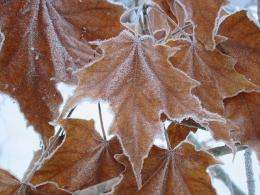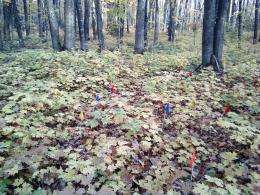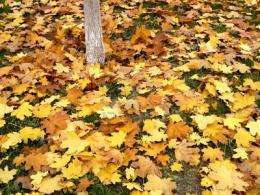Seeing the forest under the trees

(PhysOrg.com) -- Scientists recently discovered nitrogen that falls from the atmosphere in acid rain can influence large tracts of sugar maples in North America.
The atmospheric nitrogen in acid rain can affect forest ecosystems by acidifying soils and causing nutrient imbalances.
Sugar maples in northeastern North America are especially vulnerable. Vast maple areas have been affected by this acidification process, which depletes soil calcium in already calcium-poor soils such as those of the Eastern United States.
In the calcium-rich soils of the upper Great Lakes, however, acid rain also wreaks havoc, ecologists have found. It slows leaf decomposition, leading to a pile-up of leaves and hindering new young maples from sprouting up.
The researchers published their results on-line in the current issue of the Journal of Applied Ecology.
"The process has the potential to affect sugar maple-dominated forests throughout the Great Lakes region," says Donald Zak, an ecologist at the University of Michigan, "especially as nitrogen deposition continues in the future."

He and colleagues Sierra Patterson of the University of Michigan, Andrew Burton of Michigan Technological University and Alan Talhelm and Kurt Pregitzer of the University of Idaho conducted seventeen years of nitrogen deposition experiments at rates that will likely happen by the end of this century.
"The effects have slowed the natural processes of decomposition, such as the decay of dead leaves, causing the leaves to build up and the forest floor to thicken," says Zak.

The leaf-littered ground has become a barrier to the small seeds of sugar maples, hence numbers of young sugar maples--the forest's next generation--are dropping.
"There were significantly fewer seedlings in the nitrogen treatment area," says Patterson, the paper's lead author.
"Increasing the amount of fallen leaves on the forest floor caused a significant reduction in successful sugar maple seedlings," she says. "On the other hand, decreasing the thickened forest floor increased seedling survival."
"The surprising results reported in this study are an example of the value of long-term research," says Saran Twombly, program director in the National Science Foundation (NSF)'s Division of Environmental Biology, which funded the work.
"Uncovering an unexpected link between nitrogen deposition and sugar maple seedling success depended on the ability to simulate increased nitrogen deposition year after year," Twombly says.
"The manipulations used to reveal the details of this link could not have worked in other than a long-term study."
Scientists need to re-think the myriad ways in which acid rain may affect forests, Zak believes, especially those made up largely of sugar maples.
"We need to learn to see the forest," he says, "that's under the trees."
Journal information: Journal of Applied Ecology
Provided by National Science Foundation

















